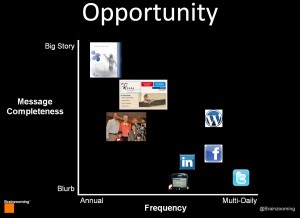I had a great opportunity to participate in a panel presentation Wednesday at the Association of Fundraising Professionals, MO, Mid-America Chapter along with Dave Svet of Spur Communications and Patrick Sallee of the American Red Cross, Greater Kansas City Chapter. The topic was "Can Your Smartphone Be a Smart Fundraiser? Mobile fundraising and other "Smart" Strategies." Short story, we all approached it from a social networking and mobile strategy angle, with insights applicable to nonprofits and for-profit businesses both.
The Other Speakers
Patrick Sallee covered actual case studies of "text to give" from his career. Patrick addressed the upsides (significant impact opportunities when tied to an attention-getting event) and downsides (set-up and ongoing costs, long payment processing cycles, challenges in reaching sufficient scale). The net of his remarks was that "text to give" yields on average about $1000 for a charity, which makes pursuing this social networking strategy not widely viable.
Dave Svet provided a solid overview of the technical opportunities and challenges of mobile giving. He covered smart phone trends that will make mobile giving more seamless domestically in a few years. Near-term, Dave underscored the importance of a mobile-enabled website and the opportunity to develop app-like features within a web environment at significantly less cost than creating custom apps.
Mobile Content Marketing Strategy
I presented on content marketing strategies for nonprofits before fund raising even starts. The mobile content marketing ideas were tied to a social networking impact model The Brainzooming Group uses. The social networking impact model is focused on maximizing audience interests, how to create compelling communication within a mobile strategy, and methods to employ social networking most effectively in sharing an organization's stories with its key audiences.
Here are five key social networking points from my section on mobile content marketing:
 It is no surprise that spouses, relatives, friends, and experts are more important to consumer brand decisions than having a Facebook or Twitter page. Two big opportunities exist for brands in social networking, though. These opportunities are to share content and a personality which moves a brand into a friend or expert role and to provide content to individual social network members they can readily and credibly share within their own social networks.
It is no surprise that spouses, relatives, friends, and experts are more important to consumer brand decisions than having a Facebook or Twitter page. Two big opportunities exist for brands in social networking, though. These opportunities are to share content and a personality which moves a brand into a friend or expert role and to provide content to individual social network members they can readily and credibly share within their own social networks.- Develop relevant personas for important audiences to improve addressing audience needs and interests with your content. Write content for individuals (not for the masses) about what your organization thinks, knows, and does.
- In a mobile environment, compelling communication requires brevity, direct calls to action, integrated messaging, a mobile-enabled website, and easy ways to invite people to deeper information.
- When making the move from solely traditional communication vehicles (annual reports, quarterly newsletters, events, etc.) to include social media, take advantage of the opportunity for greater frequency to share a more complete organizational message. Quarterly Facebook status updates do not cut it.
- In addition to sharing stories of the people and personalities associated with your organization, make it easy for your audience to share your content via social sharing.
What Questions Does this Prompt?
Beyond the talks from Patrick Sallee, Dave Svet, and me, there were some intriguing questions from the group on social networking, technology, and content marketing. Look for a future post addressing audience questions from the Association of Fundraising Professionals session on social networking and mobile content marketing strategy. Do you have any questions you'd like to throw in the mix before that post? – Mike Brown
 If you’re struggling with determining ROI and evaluating its impacts, download “6 Social Media Metrics You Must Track" today! This article provides a concise, strategic view of the numbers and stories that matter in shaping, implementing, and evaluating your strategy. You’ll learn lessons about when to address measurement strategy, identifying overlooked ROI opportunities, and creating a 6-metric dashboard. Download Your Free Copy of “6 Social Media Metrics You Must Track!”
If you’re struggling with determining ROI and evaluating its impacts, download “6 Social Media Metrics You Must Track" today! This article provides a concise, strategic view of the numbers and stories that matter in shaping, implementing, and evaluating your strategy. You’ll learn lessons about when to address measurement strategy, identifying overlooked ROI opportunities, and creating a 6-metric dashboard. Download Your Free Copy of “6 Social Media Metrics You Must Track!”



